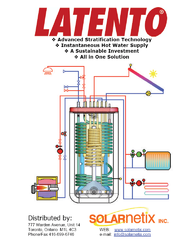I have spent the last several weeks going through all 39 pages of this site and several dozen posts, mostly dealing with storage. Great site with tons of info but I didn’t find anyone who has done what I have been planning. I will try to explain and invite your critique.
Basically it consists of a tank within a tank. I need 180* water to the house for the baseboard heat and 120* water to the barn for the yet to be installed radiant floor heat. I know I could use mixers but how is this for an idea:
An outer poured concrete wall approx 7w x 10L x 8d with an interior tank of layed up block approx. 5w x 8L x 8d. The inner tank of 180* water will be ringed by the outer tank of 120* water. Any lateral BTU migration from the inner tank will end up in the outer tank. The exterior walls will be insulated against the earth, with the inside of the outer tank will be epoxy painted. The interior of the inside tank will be insulated and a rubber liner installed. What I wind up with is an interior 2000 gallon tank with 180* water surrounded by 2000 gallons of 120* water. This creates a Delta T for the outside tank of about 70* and a Delta T for the inside tank of about 60*.
The interior tanks walls will have no pressure on them (as long as the two tanks are filled at the same time) and will only act as the barrier between the two temperatures. I plan to insulate everything in a like manner to what I have been reading in these posts.
A lady I know bought a very large Victorian home and ripped out the 4 year old hydronic system to put air back in. She asked me how much I would charge to remove the oil fired boiler with 6 zones and six circulators with a 100 gallon zoned DHW tank along with many, many copper valves and hundreds of feet of copper pipe and finned baseboard. I told her it had a lot of value and she said “ Well then you won’t charge me as much.” I felt so guilty that I never sent her a bill and she is still asking for one.
That was a long story but it will help to explain how I plan to set up the hx. On the bottom of each tank I will use finned baseboard pipe for heat in from the boiler and on the top of each tank I will use it for heat out. The reectangular shape with 8 ft depth should yield excellant stratification. To protect the finned pipe I plan on using a sacrificial anode.
There is a lot more I could explain but I hope you get the idea and offer some comments.
Gary
Basically it consists of a tank within a tank. I need 180* water to the house for the baseboard heat and 120* water to the barn for the yet to be installed radiant floor heat. I know I could use mixers but how is this for an idea:
An outer poured concrete wall approx 7w x 10L x 8d with an interior tank of layed up block approx. 5w x 8L x 8d. The inner tank of 180* water will be ringed by the outer tank of 120* water. Any lateral BTU migration from the inner tank will end up in the outer tank. The exterior walls will be insulated against the earth, with the inside of the outer tank will be epoxy painted. The interior of the inside tank will be insulated and a rubber liner installed. What I wind up with is an interior 2000 gallon tank with 180* water surrounded by 2000 gallons of 120* water. This creates a Delta T for the outside tank of about 70* and a Delta T for the inside tank of about 60*.
The interior tanks walls will have no pressure on them (as long as the two tanks are filled at the same time) and will only act as the barrier between the two temperatures. I plan to insulate everything in a like manner to what I have been reading in these posts.
A lady I know bought a very large Victorian home and ripped out the 4 year old hydronic system to put air back in. She asked me how much I would charge to remove the oil fired boiler with 6 zones and six circulators with a 100 gallon zoned DHW tank along with many, many copper valves and hundreds of feet of copper pipe and finned baseboard. I told her it had a lot of value and she said “ Well then you won’t charge me as much.” I felt so guilty that I never sent her a bill and she is still asking for one.
That was a long story but it will help to explain how I plan to set up the hx. On the bottom of each tank I will use finned baseboard pipe for heat in from the boiler and on the top of each tank I will use it for heat out. The reectangular shape with 8 ft depth should yield excellant stratification. To protect the finned pipe I plan on using a sacrificial anode.
There is a lot more I could explain but I hope you get the idea and offer some comments.
Gary



